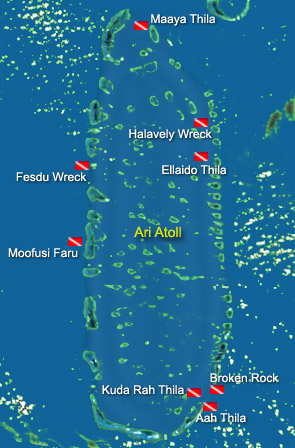Ari Atoll
Located in the western part of the Maldives Islands, the Ari Atoll is one of the largest atolls in the Maldives, and as such is home to a wide selection of dive sites.

Broken Rock
Named for a large broken rock at the center of this dive site, Broken Rock is home to a beautiful array of soft and hard coral formations that attract a wide variety of reef. There is a channel that divers can swim through, giving the dive an interesting dimension. Broken Rock varies in depth from 40 to 100 feet. Sometimes, there can be very strong currents at Broken Rock. Among the marine life often seen at Broken Rock, common sightings include the puffer fish, trigger fish, moray eels, and Napoleon wrasse.
Gangehi Kandu
Recommended only for advanced scuba divers, the Gangehi Kandu dive site is located in the northern part of the Ari Atoll. Currents here can also be challenging, and the site should only be dived when the currents are flowing into the site. Gangehi Kandu is known as one of the best dive sites in the Maldives for spotting sharks, including gray reef sharks, white tip reef sharks and the occasional leopard shark. Coral formations at this dive site are particularly colorful, and divers here can expect to see moray eels, nudibranch, mantis shripm, and trigger fish. Large pelagic species are also frequent visitors to the site.
Hukrueli Faru (Rangali Madivaru)
Commonly known as Rangali Madivaru or just Madivaru, Hukrueli Faru is home to a very colorful coral reef. The site is named for the abundance of manta rays seen here (Madi means manta ray in the Maldivian language. Depths at Hukrueli Faru range from 8 to 30 meters (25 feet to 100 feet), making the dive particularly interesting and varied. Manta rays are attracted to Hukrueli Faru because of the strong currents that form a whirlpool effect in the deeper parts of the site, where they can hover over the currents. The mantas are also attracted to the cleaning stations located around Hukrueli Faru.
Kudarah Thila
Declared a Marine Protected Area (MPA) by the Maldivian government, Kudarah Thila is a popular dive site which enjoys many incoming currents. Coral reef formations at Kudarah Thila are bright and colorful, including a variety of soft and hard corals. Thila means “pinnacle” in Dhivehi, and at Kudarah Thila there are actually four pinnacles, which can be all visited in one dive. A swim-through at the south-east corner of the dive site makes this a particularly popular dive, as does the rich variety of marine life, which includes trumpet fish, snapper, gobies, dartfish, oriental sweetlips, and grouper. Further away from the reef, divers are likely to see gray reef sharks, napoleon fish and sea turtles.
Maalhos Thila
Maalhos Thila is only suitable for experienced scuba divers because the best part of the dive site lies deeper than 25 metres. Maalhos Thila is an attractive dive spot, featuring several coral heads about 28 metres below the surface, all of which are covered with beautiful corals. Common visitors to the reef here include oriental sweetlips, white tip reef sharks and blue-lined snappers. Because of the strong currents at Maalhos Thila, a safety sausage must be deployed here to ensure the divers’ safety.
Maaya Thila
Maaya Thila is one of the most famous dive sites in the Maldives and is known as a great spot for both day and night dives. The marine life seen at Maaya Thila depends largely on the currents, which vary greatly; when the currents are not strong, Maaya Thila is an easy dive site, suitable for less experienced divers, but when currents are strong Maaya Thila is recommended for only advanced divers and they will need to use a safety sausage.
Maaya Thila is most famous for the white tip reef sharks that can nearly always be seen here, both during the day and night. On a night dive at Maaya Thila, divers will likely encounter moray eels, turtles, octopus and stonefish.
Mushi Mas Mingili Thila (Fish Head)
Fish Head, or Mushi Mas Mingili is one of the most popular dive sites in Maldives. Prior to the site being declared an official Marine Protected Area by the Maldivian Government it was a common shark feeding spot among scuba divers. Marine life typically seen at Mushi Mas Mingili Thila includes gray reef sharks, white tips, Napoleon wrasse, jacks and tuna.
Pannettone (Kalhahandi Kandu)
Kalhahandi Kandu has earned the nickname Pannettone from the many Italian divers who believe it resembles the traditional Italian fruitcake. It is an attractive dive site, recommended mainly for advanced scuba divers, except for when the currents are not strong. There are some spectacular coral formations here, featuring a variety of soft and hard coral species, which attract a wide selection of fish including angelfish, basslets, butterfly fish, scorpion fish, trigger fish and puffer fish. The corals here are in good condition and weather conditions at Pannettone mean the dive site can be explored year-round.